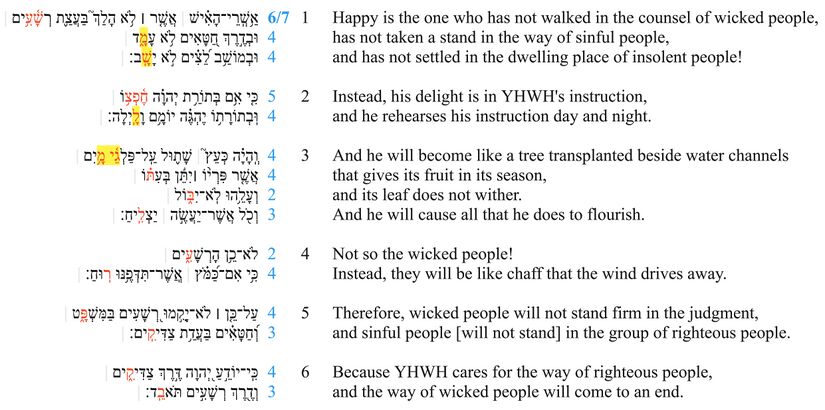Psalm 1 Poetic Structure
Poetic Structure
In poetic structure, we analyse the structure of the psalm beginning at the most basic level of the structure: the line (also known as the “colon” or “hemistich”). Then, based on the perception of patterned similarities (and on the assumption that the whole psalm is structured hierarchically), we argue for the grouping of lines into verses, verses into sub-sections, sub-sections into larger sections, etc. Because patterned similarities might be of various kinds (syntactic, semantic, pragmatic, sonic) the analysis of poetic structure draws on all of the previous layers (especially the Discourse layer).
Poetic Macro-structure
If an emendation or revocalization is preferred, that emendation or revocalization will be marked in the Hebrew text of all the visuals.
| Emendations/Revocalizations legend | |
|---|---|
| *Emended text* | Emended text, text in which the consonants differ from the consonants of the Masoretic text, is indicated by blue asterisks on either side of the emendation. |
| *Revocalized text* | Revocalized text, text in which only the vowels differ from the vowels of the Masoretic text, is indicated by purple asterisks on either side of the revocalization. |
| v. 1 Happy is the one who has not walked in the counsel of wicked people, has not taken a stand in the way of sinful people, and has not settled in the dwelling place of insolent people! | Happy is the one | ...who has not taken a stand in the way of sinful people, but follows the way of YHWH's instruction. He will flourish like a tree! | admiration | |
| v. 2 Instead, his delight is in YHWH's instruction, and he meditates on his instruction day and night. | ||||
| v. 3 And he will become like a tree transplanted beside water channels that gives its fruit in its season and whose leaves do not wither. And he will cause all that he does to flourish. | ||||
| v. 4 Not so the wicked people! Instead, they will be like chaff that the wind drives away. | Not so the wicked | When judgment comes, they will be blown away like chaff and will not stand with the righteous. | contempt | |
| v. 5 Therefore, wicked people will not stand firm in the judgment, and sinful people [will not stand] in the group of righteous people. | ||||
| v. 6 Because YHWH cares for the way of righteous people, and the way of wicked people will come to an end. | Because YHWH | ...cares for the way of the righteous, and the way of wicked people will come to an end. | confidence |
Notes
The structure of Ps 1 is extremely intricate, and it could be visualized in a number of different ways. The visual below highlights only a few of the most prominent structural features.[1]
- The psalm is bound by an inclusio.
- The word "way" (דֶּרֶךְ) appears only in the first and last verses (vv. 1, 6).
- The first word of the psalm begins with alef (the first letter of the Hebrew alphabet) and the last word of the psalm begins with tav (the last letter of the Hebrew alphabet). (Cf. the same feature in Ps 5 and Ps 112).
- The psalm consists of a body (vv. 1-5) and a summary conclusion (v. 6).
- The body of the psalm is bound by an inclusio. Note the negated verbs of movement (v. 1: "has not walked... taken a stand... settled" // v. 5: "will not stand") and the similarity of sound between בַּעֲצַת רְשָׁעִים (v. 1) and בַּעֲדַת צַדִּיקִים (v. 5). In other words, the main body of the psalm begins with the righteous not standing with the wicked, and it ends with the wicked not standing with the righteous.
- Verse 6 functions as a grounding summary of the entire discourse.
- Verse 6a summarizes vv. 1-3, and v. 6b summarizes vv. 4-5.
- The כִּי in v. 6 grounds the entire discourse.[2] It explains, in summary, why the righteous (and not the wicked) are to be considered "happy."
- It is a common pattern in the Psalter for the final verse to begin with כִּי and function as a summary of the whole (see e.g., Pss 5, 11, 100, 134).
- The body of the psalm (vv. 1-5) divides naturally into two main sections (vv. 1-3; vv. 4-5).
- The discourse topic of the first section is "the one" (הָאִישׁ) and the discourse topic of the second section is "the wicked people" (הָרְשָׁעִים). Each topic is introduced with the definite article (the only two instances of the explicit ה article in the psalm).
- The two sections have similar beginnings.[3]
- As noted above, each section begins by introducing the topic of the section and uses the definite article: "the one" (הָאִישׁ) // "the wicked people" (הָרְשָׁעִים)
- Each section begins with a sentence fragment: "the happiness of the one! // "not so the wicked people!" These are the only two fragments in the psalm.
- There is a similarity of sound between הָרְשָׁעִים and אַשְׁרֵי הָאִישׁ (note esp. the sounds sh, and r).
- The two sections parallel one another in other ways. For example, each section follows the sequence of a negative (לֹא, v 1 // v. 4), followed by a contrast (כִּי אִם, v. 2 // v. 4), followed by an agricultural simile (כְּעֵץ // כַּמֹּץ, v. 3 // v. 4), followed by a relative clause (אֲשֶׁר, v. 3 // v. 4).
- Each of the two sections exhibits syntactic cohesion.
- In the first section (vv. 1-3), vv. 1-2 are bound together syntactically by the logical connector כִּי אִם, and vv. 2-3 are bound together syntactically by waw (והיה).
- The two verses of the second section (vv. 4-5) are bound together syntactically by עַל־כֵּן.
Another way to think about the structure of Ps 1 is with the image of a chain (see below). Each verse is like a link in the chain, bound to both the immediately following and preceding verse. So, for example, v. 1 is the first link, and it is tightly bound to v. 2. Verse 2, in turn, is also bound to v. 3, and v. 3 is also bound to v. 4, etc.
- vv. 1-2. "not in (ב) the counsel of the wicked... Instead, in (ב) YHWH's instruction"
- vv. 2-3. "he delights in... and rehearses his instruction day and night. And (as a result) he will become like a tree transplanted by water channels..." Note especially the sound play between "rehearses day and night" (יֶהְגֶּה יוֹמָם וָלָיְלָה) and "beside water channels" (עַל־פַּלְגֵי מָיִם).
- vv. 3-4. "like a tree... that... like chaff that..." "Tree" and "chaff" not only belong to a similar lexical domain, they even sound similar (one syllable words ending in ץ).
- vv. 4-5. The image of "chaff" is closely associated with legal/courtroom imagery. Because the wicked are like chaff (v. 4), "therefore, the wicked will not stand firm in the judgment..."
- vv. 5-6. The word "righteous people" (צַדִּיקִים) occurs only in these verses.
Line Divisions
Line division divides the poem into lines and line groupings. We determine line divisions based on a combination of external evidence (Masoretic accents, pausal forms, manuscripts) and internal evidence (syntax, prosodic word counting and patterned relation to other lines). Moreover, we indicate line-groupings by using additional spacing.
When line divisions are uncertain, we consult some of the many psalms manuscripts which lay out the text in lines. Then, if a division attested in one of these manuscripts/versions influences our decision to divide the text at a certain point, we place a green symbol (G, DSS, or MT) to the left of the line in question.
| Poetic line division legend | |
|---|---|
| Pausal form | Pausal forms are highlighted in yellow. |
| Accent which typically corresponds to line division | Accents which typically correspond to line divisions are indicated by red text. |
| | | Clause boundaries are indicated by a light gray vertical line in between clauses. |
| G | Line divisions that follow Greek manuscripts are indicated by a bold green G. |
| DSS | Line divisions that follow the Dead Sea Scrolls are indicated by a bold green DSS. |
| M | Line divisions that follow Masoretic manuscripts are indicated by a bold green M. |
| Number of prosodic words | The number of prosodic words are indicated in blue text. |
| Prosodic words greater than 5 | The number of prosodic words if greater than 5 is indicated by bold blue text. |
If an emendation or revocalization is preferred, that emendation or revocalization will be marked in the Hebrew text of all the visuals.
| Emendations/Revocalizations legend | |
|---|---|
| *Emended text* | Emended text, text in which the consonants differ from the consonants of the Masoretic text, is indicated by blue asterisks on either side of the emendation. |
| *Revocalized text* | Revocalized text, text in which only the vowels differ from the vowels of the Masoretic text, is indicated by purple asterisks on either side of the revocalization. |
Notes
- The proposed line division agrees completely with the Septuagint.[4]
- The first line is rather long (6 words). In the Aleppo Codex, where there is no maqqef (אַ֥שְֽׁרֵי הָאִ֗ישׁ), the line is even longer (7 words). The fact that the Psalter begins with a seven-word line, however, might be deliberate, perhaps echoing the seven-word clause that begins the Torah (Gen 1:1).





